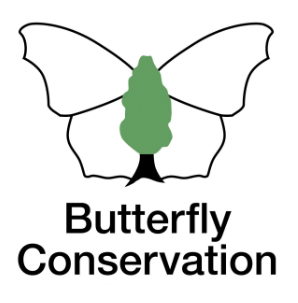Brown Argus
Brown Hairstreak
Chalkhill Blue
Clouded Yellow
Comma
Common Blue
Dark Green Fritillary
Dingy Skipper
Essex Skipper
Gatekeeper
Green Hairstreak
Green-veined White
Grizzled Skipper
Holly Blue
Large Skipper
Large White
Marbled White
Meadow Brown
Orange-tip
Painted Lady
Peacock
Purple Emperor
Purple Hairstreak
Red Admiral
Ringlet
Silver-washed Fritillary
Small Blue
Small Copper
Small Heath
Small Skipper
Small Tortoiseshell
Small White
Speckled Wood
Wall
White Admiral
White-letter Hairstreak
Extinct/rare immigrants
Small White
Pieris rapae
General Distribution and Status
The Small White is a widespread and common butterfly throughout Britain boosted by immigrants from Europe. It appears that the butterfly did not suffer as badly as the Large White after the last war by the increased intensification in agriculture and pesticide use. It was found that application of pesticide, DDT, killed off an increased number of larval predators such as ground beetles and harvest spiders resulting in an increased number of larvae later in the season (Heath et al.). Numbers have dropped by about a quarter since 1976 but have stabilised since 2009 in spite of a poor run prior to 2018 which was a spectacular year for the butterfly (Brereton et al.). In Hertfordshire and Middlesex, only since 2011 has the Small White recovered up to the level of the mid 1990s in terms of abundance which may be due to the heavy presence of oil-seed rape in the county (Wood, 2012). However, numbers have fallen in the last few years with 2024 probably one of the worst on record.
| United Kingdom | Herts & Middx | |||
| Distribution | 1976-2019 | -15% | 1980-2015 | 0% |
| Average 10-year trend | -3% | 2006-2015 | +17% | |
| 2024 since 2015-19 | +5% | |||
| Abundance | 1976-2024 | -18% | 1980-2015 | +1% |
| 2015-2024 | -1% | 2006-2015 | +47% | |
| 2023-2024 | -43% | 2024 since 2015-19 | -48% | |
UK distribution map
UKBMS Species summary
Habitat Requirements
The species is found in most habitats but more so on waste ground, gardens and allotments where cultivated brassicas are grown. Fields containing oil-seed rape are also frequented.
Larval Foodplants
Cabbage Brassica spp., Water Cress Rorippa nasturtium-aquaticum. Hedge Mustard Sisymbrium officinale, Garlic Mustard Alliaria petiolata, Hoary Cress Cardaria draba and Wild Mignonette Reseda lutea are also sometimes used (Sawford).
Adult Food Sources
Buddleia Buddleja davidii (685), Garden Lavender Lavandula x intermedia (299), Horseradish Armoracia rusticana (94), Creeping Thistle Cirsium arvense (94), Bramble Rubus fruticosus agg. (91). Burdock Arctium spp. and Black Horehound Ballota nigra are also mentioned (Wood 2016).
Historical Records
It seems that the Small White has always been very common in Hertfordshire. For instance, Foster in 1934 describes it as 'generally abundant' and in 1959 there were reports of third brood specimens (Bell). I did not find any evidence of dwindling numbers in the county up to the 1970s and like most species the 1976 drought had an adverse affect with populations plummeting in the following year.
Local Distribution and Abundance
The Small White is present in every tetrad as shown on the map. Good numbers occur at Great Ashby Park, Knebworth Park and Fairlands Valley Park.Estimates of 100 specimens were recorded at Astonbury Wood on 13 August 1997 and at Cherrys Farm in Weston on 19 August 1997. After two very productive seasons in 2020 and 2021 numbers have fallen back. Reports for 2024 indicate that numbers were less than half of those in 2023.

Stevenage (South Fairlands Valley Park) transect 1993-2025
Like the Large White a warm and dry summer does not necessarily mean there will be a higher number of Small Whites flying. The best season was in 2004 when there was a cool and wet summer although the last week of July brought in dry and humid air from the Continent which could have led to an increased migration to the UK. A combined count of about 100 specimens was recorded on 24 and 31 July 2004.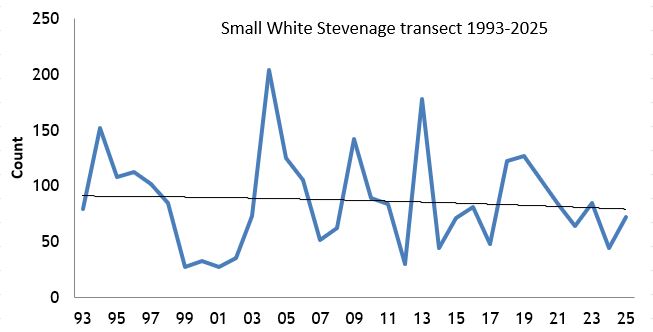
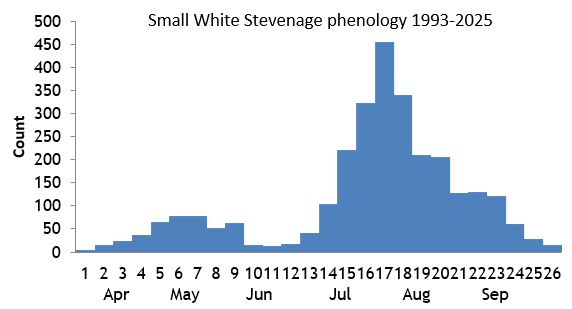
Knebworth Park transect 1996-2010 and 2017-2025
2018 turned out to be an incredible year for the Small White here, the best ever during the survey. There was a good first brood in May, and numbers jumped significantly in the second brood perhaps partly due to the fine weather in June, to reach nearly 100 on 9 July, nearly half of which were found at Burleigh Bottom at the northern tip of Graffidge Wood.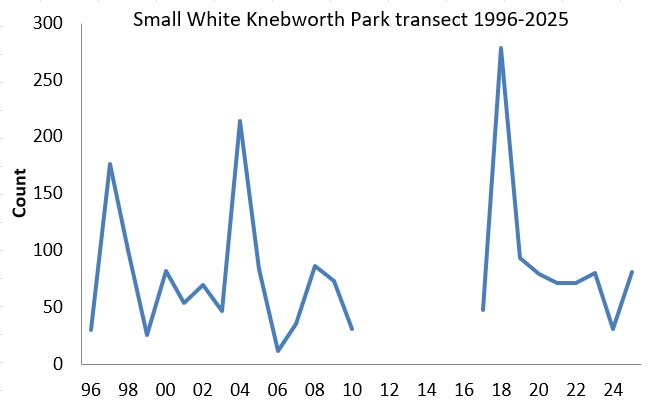

Knebworth Woods transect 2017-2025
Numbers nearly doubled in 2018 with a count of 33 on 16 July and although the trend is negative since then numbers increased in 2025 due to the fine weather and possible partial immigration.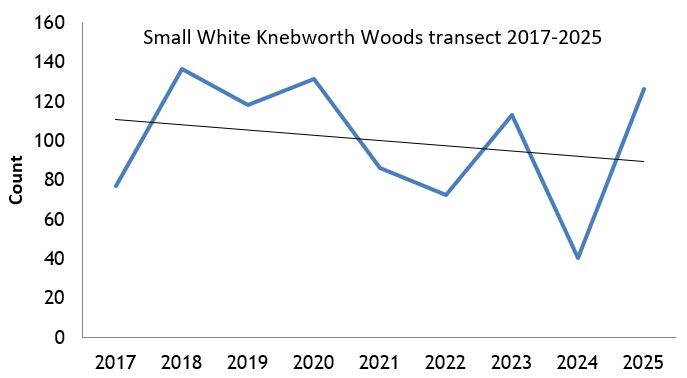
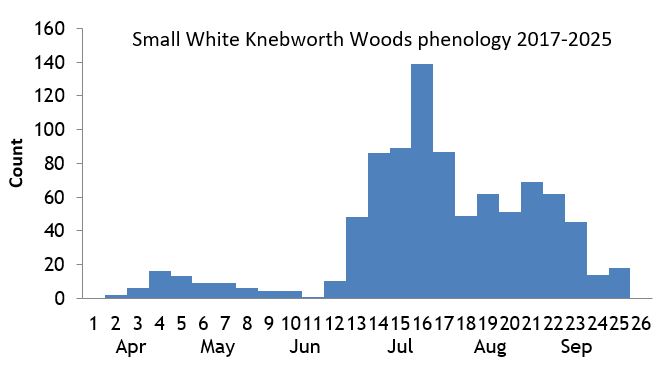
Pryor's Wood transect 2000-2022
Numbers are relatively stable although in 2016 and 2017 only five individuals were recorded in all. 2008 was the best year with a count of 18 although the highest weekly count was 11 on 24 July 2004. Only three were seen in 2022.Life History
Earliest date: 16 March 2014 at Walkern
Latest date: 28 October 2016 at Roebuck
Any warm weather in early spring
should accelerate development of the overwintering pupae and adults emerge by early April. The second generation is always larger than the first based on
results in this survey and is bolstered by Continental immigrants but it is unknown if the immigration is the only or major cause. The sighting on 28
October in a garden in Roebuck in 2016 is the latest ever record in the Stevenage area. Eggs are laid singly
on a number of wild foodplants under a leaf. Larvae eat the leaves leaving characteristic holes. When fully grown, they move away from the foodplant to
pupate on tree trunks, fences and buildings.
Behaviour/Observation notes
The Small White is probably the most common 'white' to visit gardens to feed on flowers. In hot and dry weather, aggregations may be found imbibing minerals from mud. It can be confused with the Green-veined White in flight but to the trained eye it might be possible to differentiate them by their behaviour. Small Whites tend to make more purposeful flights but this is by no means a reliable guide. Another clue is the habitat; if it is a damp or shady place it is more likely to be a Green-veined White but again not a hard and fast rule.
Variations/Aberrations
Variation in the ground colour of the uppersides and the extent of the dark markings are the main aberrations but these are rare and most apparent in
Scotland and Ireland.
Find out more on the UK Butterflies website
References
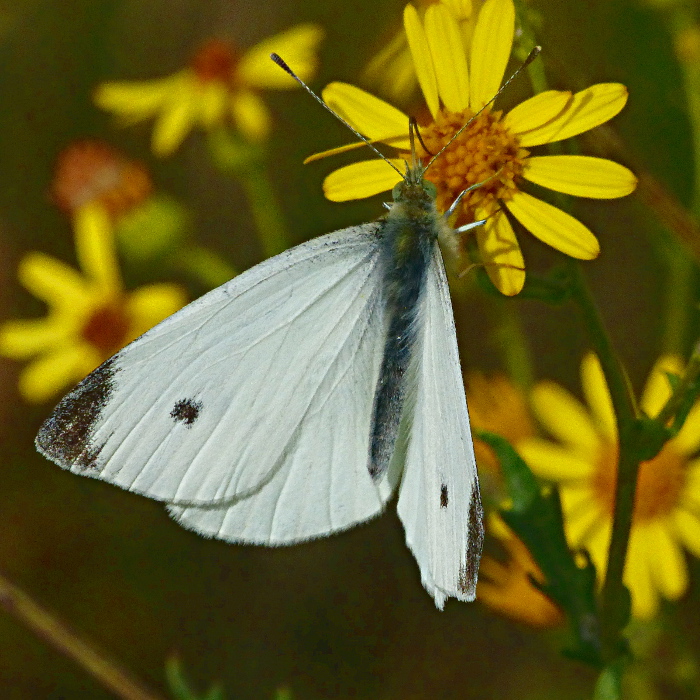
Cannocks Wood 31 Aug 2019 (m)
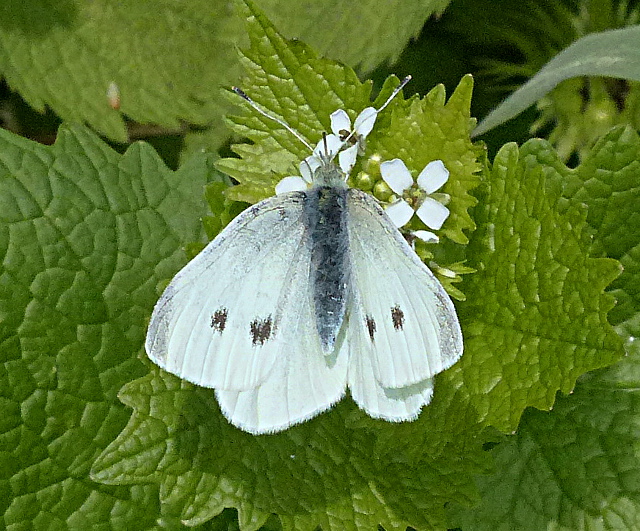
Graveley 3 May 2016 (f)
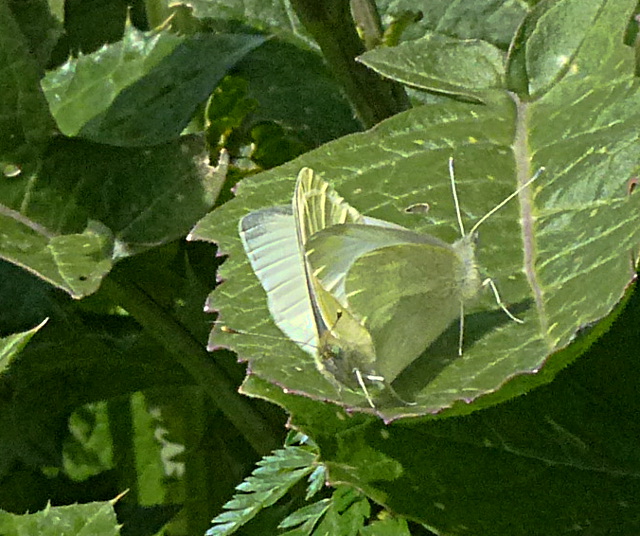
Near Stevenage Leisure Park 13 Apr 2016
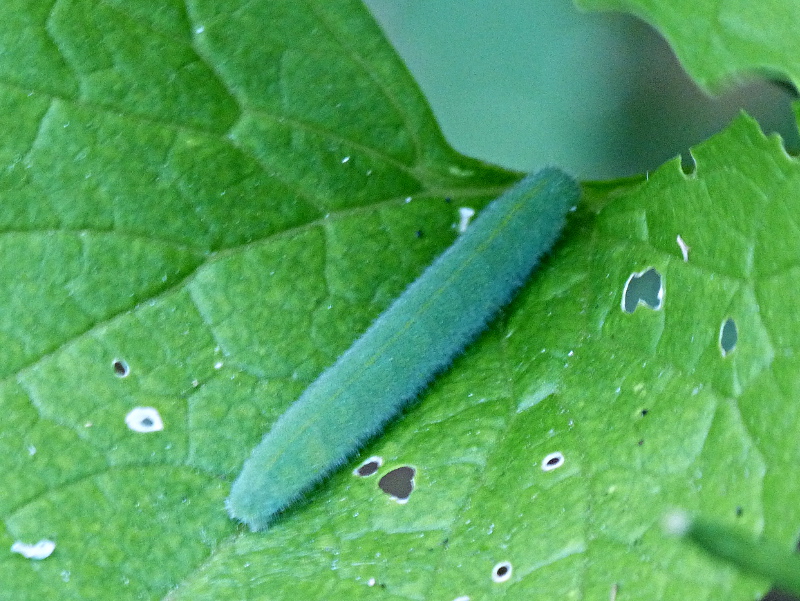
Larva Stevenage garden 28 Jun 2018
